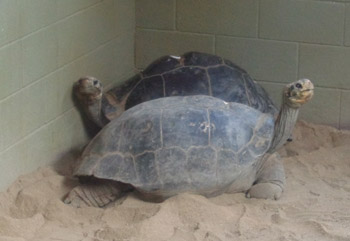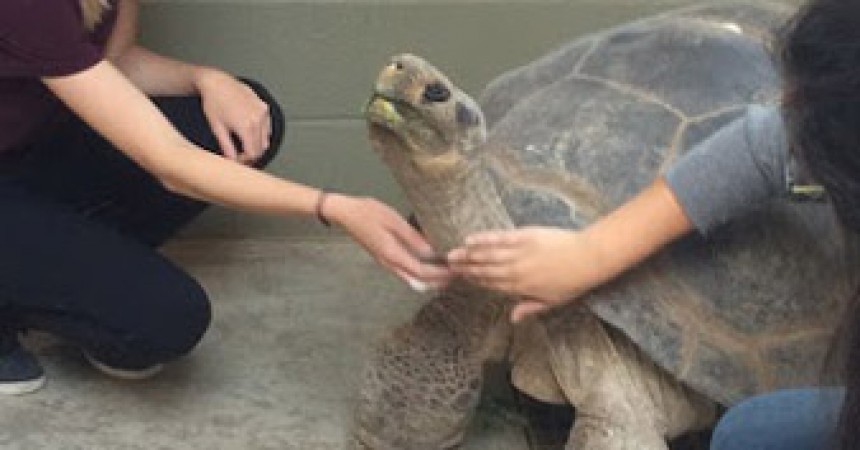Zoo InternQuest is a seven-week career exploration program for San Diego County high school juniors and seniors. Students have the unique opportunity to meet professionals working for the San Diego Zoo, Safari Park, and Institute for Conservation Research, learn about their jobs, and then blog about their experience online. Follow their adventure here on the Zoo’s website!
 This week, the final one for the interns, was enlightening as we got to meet and speak with Peter Gilson, reptile and amphibian keeper at the San Diego Zoo. Mr. Gilson has been caring for the residents at the Reptile and Amphibian House for over nine years, helping ensure they have long and enjoyable lives. Moreover, interns had the amazing opportunity to talk with Mr. Gilson and meet some of these outstanding animals, an experience that I am sure not to forget.
This week, the final one for the interns, was enlightening as we got to meet and speak with Peter Gilson, reptile and amphibian keeper at the San Diego Zoo. Mr. Gilson has been caring for the residents at the Reptile and Amphibian House for over nine years, helping ensure they have long and enjoyable lives. Moreover, interns had the amazing opportunity to talk with Mr. Gilson and meet some of these outstanding animals, an experience that I am sure not to forget.
Upon arrival at the Amphibian House, Mr. Gilson brought us inside to show us the Zoo’s collection of common and rare amphibians. The Zoo alters the temperature of the building so that it can mimic the amphibian’s natural habitat, a feature that is essential for the animals’ welfare. With a background in herpetology and a major in environmental sciences, Mr. Gilson has always had the passion to work with reptiles and amphibians. Built in 2011, the Amphibian house has some of the most up-to-date equipment available for keepers. With care tanks for tadpoles, realistic enclosures, and custom temperature and humidity control, the Amphibian house is one of the most high tech buildings at the Zoo. After showing us around the building, Mr. Gilson brought out a couple of amphibians for us to meet, one of those being the Kaiser newt. An animal with unique biological abilities, Mr. Gilson explained to us about new medical advancements that could be discovered from the Kaiser newt. With the ability to regrow certain parts of their body, doctors and scientists believe that humans could develop new technology that allows us to regrow parts of our body. Scientists are using salamanders and newts to study and learn how they regrow injured or damaged parts of their body. This form of inspiration, or modeling of an animal, is called biomimicry. Who knew amphibians could be an integral role in cutting edge medical technology!
After touring the amphibian house, Mr. Gilson brought us over to the very similar native species building. Nearly identical in nature, the native species building also moderates temperature and humidity to keep the animals comfortable. In doing so, the Zoo can maintain seasonal temperatures, which give cues to the animals to perform certain behaviors such as mating. With so many animals to keep watch over and feed, the Zoo receives three shipments of food a week for the amphibians and reptiles alone! However, most reptiles only are fed once every two weeks. Good thing too, otherwise the keepers would have to work non-stop!
With so many species on the brink of extinction, and with work to be done, there are tons of ways you, the reader, can help! By spreading the word about amphibians and reptiles, helping in habitat restoration, and discouraging the illegal pet trade, the public has a very important role to play if we are going to bring back many of these species back from the brink of extinction. Mammals and other large animals may get most of the attention, but these smaller animals need our help too.
To finish off the day, Mr. Gilson led us over to the Galapagos tortoise barn. Upon entering the barn, all the interns had their breath taken away by the size of these magnificent animals. With the smallest one being over two hundred and fifty pounds, these animals are not one to trifle with! But do not be fooled, they love a good scratching under the neck! Showing us how to do it, Mr. Gilson allowed us to scratch the tortoises necks until they were closing their eyes blissfully. After they had had their fill of scratches, we fed the tortoises kale, which they happily enjoyed, stretching their necks out for more. Feeding and interacting with the Galapagos tortoises was the perfect, and fitting, end to our internship. In addition, perhaps there is a lesson we can learn from these gentle giants. Instead of ducking and hiding our heads from the world, maybe we should be like the Galapagos tortoises, and stick our heads out proudly, fighting hard for what we believe in.
Patrick, Real World Team
Week Six, Winter Session 2016


